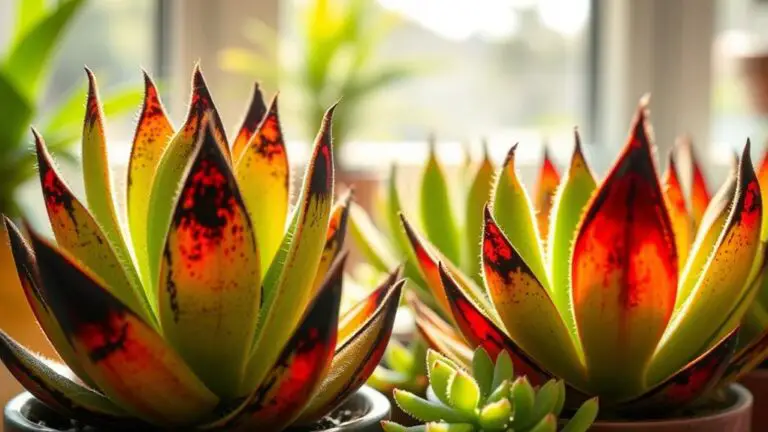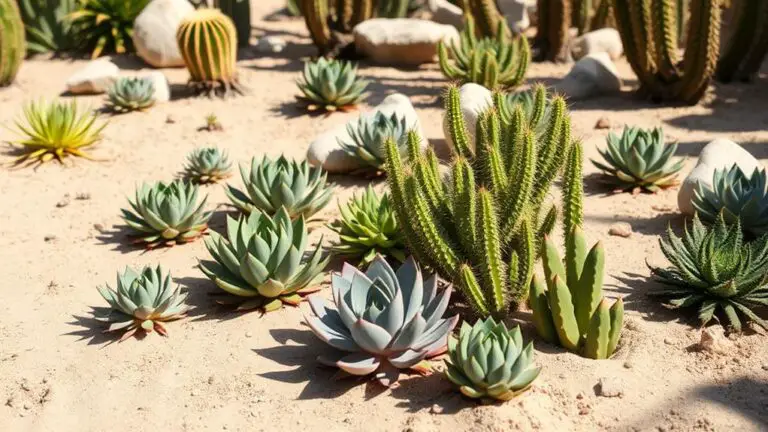10 Essential Tips for Aloe Vera Care
Caring for your aloe vera plant might seem straightforward, but there are a few essential tips you should follow to keep it thriving. From selecting the right pot and soil mix to understanding its light and watering needs, each step plays an important role in your plant's health. Don't overlook the importance of proper fertilization and pruning practices, as these can greatly impact growth. You'll also need to be vigilant about pests and adapt your care routine to the changing seasons. Ready to master the essentials for a flourishing aloe vera? Let's explore each tip in more detail.
Choose the Right Pot

Choosing the right pot for your aloe vera is vital for its health and growth. Start by selecting a wide, shallow pot with drainage holes. These holes are essential because they prevent water from sitting at the bottom, which can cause root rot.
Root rot happens when roots stay wet for too long, and it can seriously harm your plant.
Next, consider using a terra-cotta or another porous material. Terra-cotta pots are great for moisture control and allow air to circulate around the roots, helping them stay healthy.
When choosing a pot, make sure it's only 1-2 inches larger in diameter than the root ball. This size provides enough room for growth without too much extra soil, which can retain water.
It's also important to use a well-draining potting mix designed for cacti and succulents. This type of mix usually contains sand, peat moss, and perlite, ensuring excess water drains away quickly.
You should repot your aloe vera only when it becomes root-bound or top-heavy. Ideally, do this during the spring growing season to minimize stress on the plant.
Ideal Soil Mix

For your aloe vera to thrive, using an ideal soil mix is vital. Aloe plants need well-draining soil to prevent root rot, which can be deadly for them. A succulent mix is highly recommended because it's designed to provide the perfect balance of drainage and aeration.
You can create your own mix by combining equal parts of sand, peat moss, and perlite. This combination guarantees that water doesn't linger around the roots, which is essential for a healthy aloe.
Avoid using standard gardening soil. It retains too much moisture and can lead to complications like root rot. Instead, opt for terracotta pots. These pots are excellent because they allow moisture to evaporate quickly, keeping the soil's moisture level in check.
Plastic pots don't offer the same level of drainage and may hold excess moisture, which isn't good for aloe plants.
Always check the soil's moisture level before watering. Simply insert your finger about 2 inches deep into the soil. If it feels damp, hold off on watering.
This practice helps prevent excess moisture buildup, safeguarding your aloe vera's health and vibrancy. Good soil and proper drainage make all the difference!
Lighting Requirements
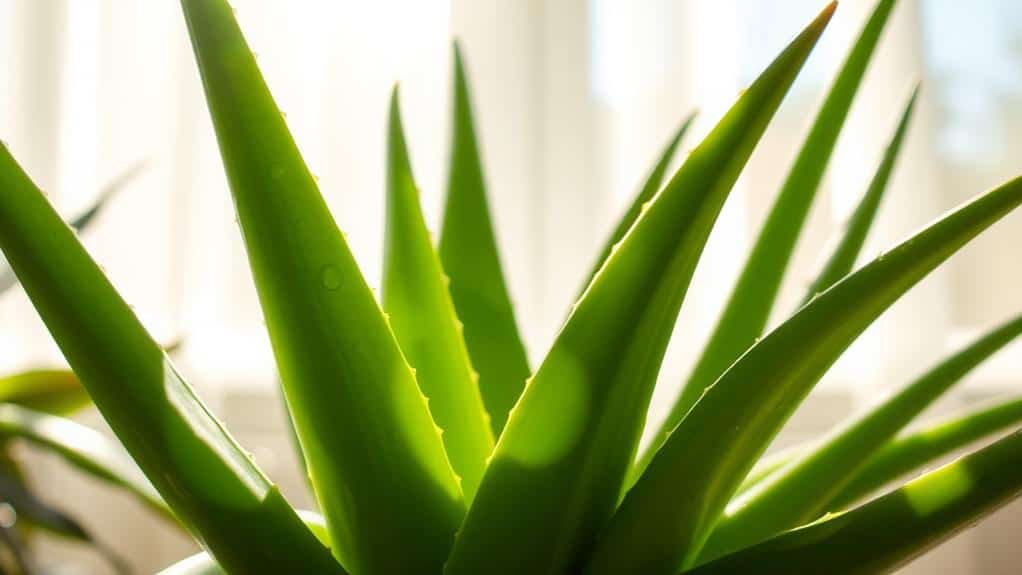
Understanding the lighting requirements of your aloe vera is crucial for its overall health and growth. Aloe vera thrives in bright indirect sunlight. Aim to provide about 2-3 hours of sunlight daily for peak growth.
However, be cautious with direct sunlight exposure, as it can cause sunburn. This damage shows up as white or light brown discoloration on the leaves, which isn't good for your plant.
For indoor aloe plants, place them near south or west-facing windows to guarantee they get the most light. If your aloe doesn't get enough light, you'll notice it becoming leggy, with long stems and drooping leaves. This is a clear sign that your plant needs brighter conditions.
During the growing season, consider moving your aloe vera outdoors. Choose a spot with filtered sunlight to enhance its growth and health.
Just make sure it's a shaded area, so your plant isn't exposed to direct sunlight for too long.
Proper Watering

While proper lighting is essential for your aloe vera, how you water it's equally important for maintaining its health. You should water your aloe plant deeply but infrequently. During the growing season, let the soil dry out completely between waterings. Typically, this means watering every 2-3 weeks.
To check if your plant needs water, insert your finger about an inch into the soil. If it feels dry, it's time to water. If it's still moist, wait a few more days.
Overwatering can lead to root rot, which shows up as mushy leaves and blackened roots. To avoid this, make sure your pot has drainage holes so excess water can escape. Never let your aloe sit in standing water.
In winter, your aloe enters dormancy and needs less moisture. Watering once a month is usually enough during this period.
Remember these key points to keep your aloe vera thriving:
- Allow the top third of the soil to dry out completely between waterings.
- Check soil moisture with your finger.
- Ensure your pot has drainage holes to prevent water buildup.
- Reduce watering in winter to match the plant's dormancy needs.
Following these tips will help you maintain a healthy, vibrant aloe vera plant.
Fertilization Tips

When it comes to fertilizing your aloe vera, choosing the right type is essential for healthy growth.
You'll want to use a diluted houseplant or succulent fertilizer at half strength in the spring, but remember to fertilize only once a month to avoid overfeeding.
Also, skip fertilizing in the winter to give your plant the rest it needs.
Choosing Fertilizers Wisely
Selecting the right fertilizer for your aloe vera is fundamental for its health and growth. You should fertilize sparingly during the growing season, typically in spring and summer, using a balanced liquid houseplant fertilizer diluted to half strength. This provides the necessary nutrients without overwhelming your plant.
Using a phosphorus-rich fertilizer can promote blooming and overall health, but make sure it's specifically formulated for succulents or cacti. Phosphorus helps strengthen the root system and boosts flowering, enhancing your aloe vera's beauty and liveliness.
It's imperative to avoid fertilizing during the fall and winter months, as your plant enters a dormancy period and doesn't need extra nutrients.
To prevent fertilizer burn, monitor your aloe vera's growth and appearance. Pale or stunted leaves could indicate a need for fertilization, but always use caution. A light top dressing of worm castings can be a gentle way to provide beneficial nutrients without the risks associated with over-fertilizing.
Here are some tips to keep your aloe vera thriving:
- Use diluted, balanced liquid fertilizer: This keeps nutrient levels safe.
- Opt for phosphorus-rich fertilizers: Boost blooming and root health.
- Incorporate worm castings: Gentle nutrient boost without over-fertilizing risks.
- Watch for signs: Pale or stunted leaves might need more nutrients.
Seasonal Fertilization Schedule
To keep your aloe vera in peak condition, establishing a seasonal fertilization schedule is crucial. Aloe vera plants thrive when fertilized sparingly. The best time to fertilize is in the spring, during their active growing season. Use a diluted houseplant or succulent fertilizer at half strength. This guarantees they get the nutrients they need without the risk of over-fertilization, which can harm them.
During the fall and winter, avoid fertilizing your aloe vera. The plant enters a dormant phase and doesn't need extra nutrients. Over-fertilizing in these months can lead to unnecessary stress and damage. Instead, focus on monitoring the plant for any signs of nutrient deficiency. Pale leaves or stunted growth are indicators that your plant might need a boost.
A helpful tip is to apply a light top dressing of worm castings in the spring. This provides natural nutrients and reduces the risk of over-fertilization.
Always make certain the soil is dry before you fertilize. This prevents root burn and helps the plant absorb nutrients effectively.
Repotting Techniques

Repotting your aloe vera is vital when the plant becomes root-bound or top-heavy, typically in the spring during its active growth period.
Start by choosing a new pot that's at least as wide as it's deep, with drainage holes to prevent water accumulation. A well-draining potting mix designed for cacti and succulents is essential, as it helps avoid the poor drainage of standard gardening soil.
When you're ready to repot, gently remove the aloe vera from its old pot. Carefully loosen the roots, and trim any that are damaged or overly long. This promotes healthy growth and prepares the plant for its new home.
Place the aloe vera in the new pot, fill around it with the well-draining mix, and press lightly to secure it.
After repotting, give the plant time to adapt. Avoid watering for at least a week to prevent rot and make sure the roots settle in.
- Feel proud of your thriving aloe vera
- Enjoy a healthier, happier plant
- Watch your aloe vera flourish
- Experience the joy of gardening success
Repotting may seem intimidating, but with these steps, you'll keep your aloe vera thriving.
Pruning Practices
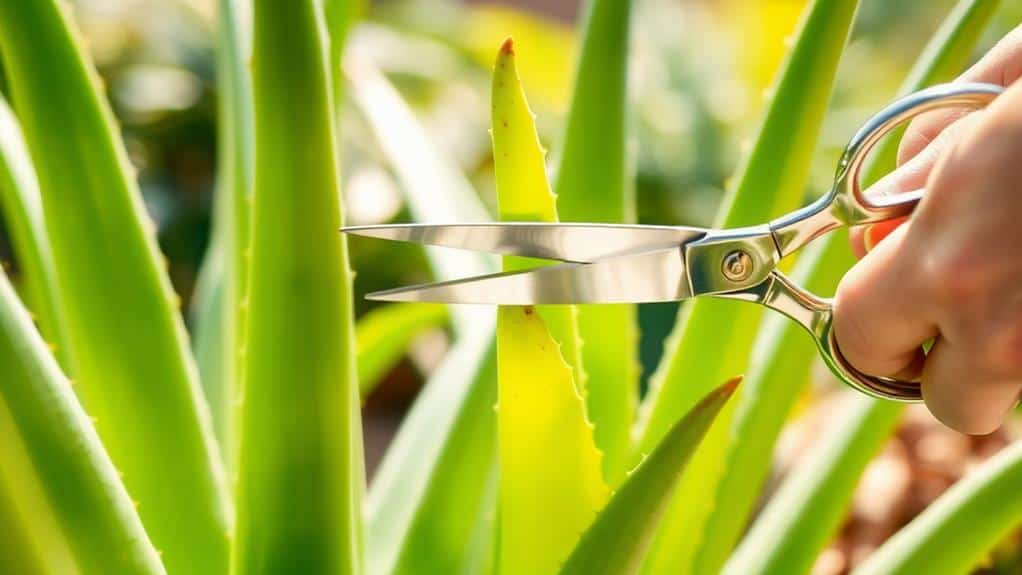
Regular pruning of your aloe vera is essential for its overall health and appearance. Start by removing brown tips and spent flower stalks to promote healthy growth.
Focus first on trimming the older leaves, working your way to the fleshier parts. It's important to leave five to six healthy leaves on the plant to allow it to absorb sunlight effectively and encourage new growth.
Always use clean, sharp tools for pruning. This helps prevent infections and guarantees you don't damage your aloe vera. Pruning can also help with pests management by removing any affected or damaged leaves, which contributes to the overall health of the plant.
When you're pruning, make sure to cut the leaves as close to the base as possible without harming the main stem. This practice not only promotes healthy growth but also makes your aloe vera look tidy and well-maintained.
Common Pests

Now, let's talk about common pests that might bother your Aloe vera.
You should watch out for mealybugs, scale insects, and orange aphids since they can weaken your plant.
Regularly inspect your Aloe for signs like leaf discoloration or sticky residue to catch any pests early and treat them promptly.
Identifying Common Pests
One of the most crucial aspects of aloe vera care is identifying and managing common pests like mealybugs, spider mites, and scale insects.
These pests can do a lot of damage if not caught early. Regular inspections are imperative for early detection and maintaining the health of your aloe vera plant.
Mealybugs look like small, white, cottony clusters on the leaves. They can be removed by using a cotton swab dipped in rubbing alcohol.
Spider mites love dry conditions and may cause tiny spots or discoloration on your plant's leaves. To deter them, increase the humidity around your plant.
Scale insects appear as small, brown, or white bumps on the surface. You can gently scrape them off with a fingernail or a soft brush.
Taking the time to check your plant for these pests will go a long way in keeping it healthy and happy.
- � Spotting these pests early can save your plant from severe damage.
- � Simple methods like using rubbing alcohol can effectively remove mealybugs.
- � Increasing humidity can keep spider mites away.
- � Gently scraping off scale insects helps protect your aloe vera.
With regular inspections and early detection, you'll guarantee your aloe vera plant thrives.
Effective Pest Treatments
Even with the best care, aloe vera plants can fall prey to common pests, but effective treatments can keep these nuisances in check.
Mealybugs are one of the most frequent pests you'll encounter. These tiny, white insects can be removed easily by dabbing them with a cotton swab dipped in rubbing alcohol. You might also notice sticky leaves on your plant, a sign of scale insects. To treat these pests, use natural treatments like neem oil or insecticidal soap.
Regular inspections are essential. Look for sticky leaves or small webs, as these are strong indicators of an infestation. Maintaining good air circulation around your aloe vera plant helps reduce the chances of pests taking hold. Avoid overcrowding your plants, as pests thrive in stagnant environments.
For minor infestations, try a gentle blast of water to dislodge pests like aphids. Be careful not to let the plant stay too wet, as this can lead to other issues like rotting.
In cases of severe infestations, it may be best to quarantine the affected plant to prevent pests from spreading to your other plants. With these treatments, you can keep your aloe vera healthy and pest-free.
Prevention and Monitoring
Caring for your aloe vera plant means being vigilant about prevention and monitoring for common pests. Regularly inspect your aloe vera for mealybugs, aphids, and scale, as these common pests can really hurt your plant's health and growth.
Keep an eye out for signs of pest infestations like leaf discoloration or a sticky residue on the leaves. These are clear indicators that harmful insects may be present.
To keep your plant healthy, try these practical tips:
- A gentle blast of water: This can dislodge aphids effectively.
- Cotton swab with alcohol: Use it to wipe off mealybugs.
- Maintain a clean growing environment: Avoid overcrowding your plants to reduce the likelihood of pests.
- Quarantine new plants: Before adding new plants to your collection, isolate them to prevent the spread of pests and diseases.
Seasonal Care

As the seasons change, so do the needs of your aloe vera plant, requiring adjustments to your care routine to keep it healthy year-round.
During the winter months, your aloe vera enters dormancy and needs less water. Reduce watering to once a month. Overwatering can cause stress and damage the plant. Keep an eye out for signs of stress like wilting leaves or poor growth, which may mean the plant isn't getting enough light or it's being overwatered.
In colder climates, bring your aloe vera indoors before temperatures drop below 50°F (10°C). Make certain it gets enough light indoors to stay healthy.
When spring arrives, your aloe vera will come out of dormancy, and you should resume regular watering. Adding a diluted succulent fertilizer once a month will help promote new growth.
As the weather warms up, consider placing your aloe vera outside to benefit from increased sunlight. However, don't forget to gradually acclimate it to avoid sunburn.
Changing the soil occasionally can also guarantee it has the right nutrients. By adjusting your care routine with the seasons, you can keep your aloe vera thriving all year.
Propagation Methods
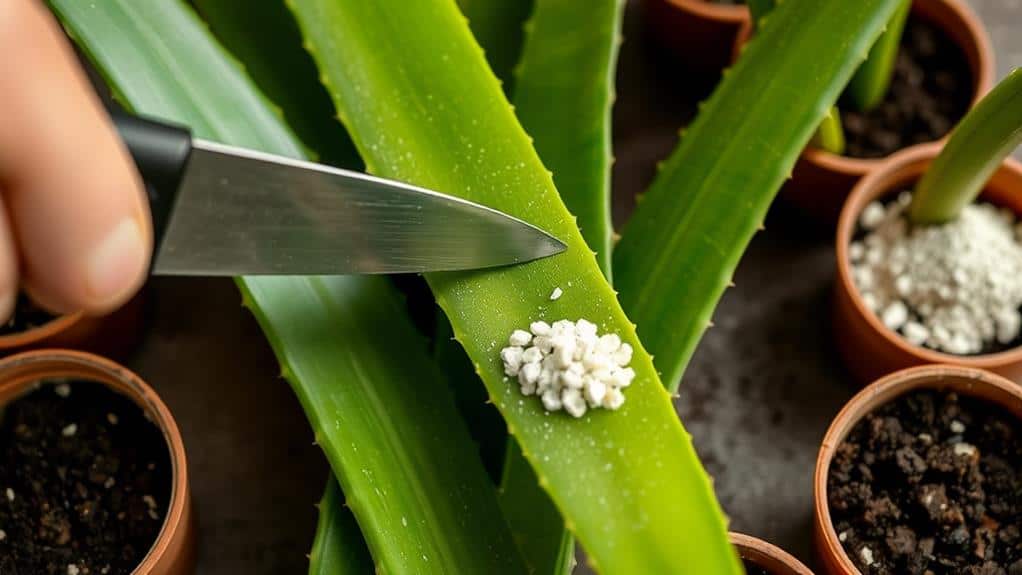
With your aloe vera thriving through the changing seasons, you might find yourself wanting to create more of these resilient plants. Propagation is a simple and rewarding process. The best way to propagate aloe vera is by using the offsets, or "pups," that grow at the base of the plant.
Here's how you do it:
- Remove the pups carefully, ensuring each has at least an inch of stem.
- Let the pups callous for 3-5 days to prevent rot.
- Pot the pups in well-draining soil.
- Monitor moisture and light conditions regularly.
It's important to know that trying to propagate aloe vera from leaf or stem cuttings won't work well, as these methods don't produce new plants. Instead, focus on the pups for the best results.
Aim to propagate during the spring and summer months when the plant is actively growing. This timing gives the new plants the best chance to root and thrive.
Once you've potted your pups, give them some love and attention, keeping an eye on their moisture levels to avoid over-watering.
Frequently Asked Questions
What Is the Best Way to Care for Aloe?
Place your aloe in bright, indirect sunlight, preferably near south or west-facing windows. Water deeply, letting the soil dry out between waterings. Use well-draining soil, fertilize sparingly, and inspect regularly for pests to keep it healthy.
What Is the Secret to Growing Aloe Vera?
The secret to growing aloe vera is providing bright, indirect sunlight, watering deeply but infrequently, using well-draining soil, fertilizing sparingly in the growing season, and repotting when necessary. Your aloe will thrive with proper care!
Should I Cut the Brown Tips off My Aloe Plant?
Yes, you should cut the brown tips off your aloe plant. Use sterilized scissors for clean cuts. Trimming improves appearance, promotes healthier growth, and helps prevent pests and diseases. Assess overall care conditions to avoid future issues.
How Do You Perk up an Aloe Vera Plant?
To perk up your aloe vera plant, make certain it gets 2-3 hours of bright, indirect sunlight daily. Water thoroughly, letting the soil dry out between waterings. Trim damaged leaves and use well-draining soil. Fertilize in spring.
Conclusion
Caring for your aloe vera doesn't have to be complicated. With the right pot, well-draining soil, and proper sunlight, you'll be on your way to a healthy plant. Don't forget to water deeply but let the soil dry out between waterings. Keep an eye out for pests and fertilize sparingly. By following these tips, you'll help your aloe vera thrive. You've got this, and your plant will thank you with its vibrant growth!





